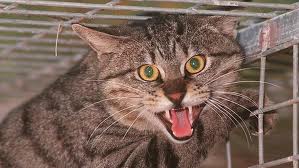FERAL CATS
A feral cat is a descendant of a domesticated cat that has returned to the wild. It is distinguished from a stray cat, which is a pet cat that has been lost or abandoned, while feral cats are born in the wild; the offspring of a stray cat can be considered feral if born in the wild.


In many parts of the world, feral cats are descendants of domestic cats that were left behind by travelers.
Because cats are not native to all parts of the world, feral cats can cause harm to local environments by preying on local species.
This is especially true on islands where feral cats have sometimes had a substantial and deleterious effect on the local fauna.
Feral cats in Australia have caused the decline and extinction of animals on islands as they have been shown to cause a significant
impact on ground birds and small native mammals. Feral cats have also stopped any attempts to re-introduce threatened species back into areas where they have become extinct as the cats have simply hunted and killed the newly released animals.
Numerous Australian environmentalists claim the feral cat has been an ecological disaster in Australia,
inhabiting most ecosystems except dense rainforest, and being implicated in the extinction of several marsupial and placental mammal species.
Although a researcher disagrees with this view (Abbot 2002).
Some others believe that there is little sound evidence that feral cats significantly affect native wildlife
throughout the mainland and that it is only on the islands that they are a threat (Jones 1989; Wilson et al. 1992).
Difficulties in separating the effects of cats from that of foxes (also introduced) and environmental effects have hindered research into this.
